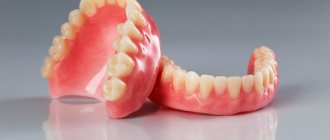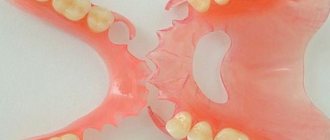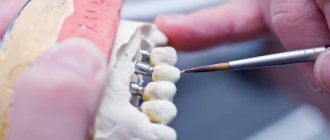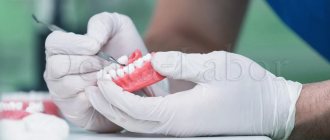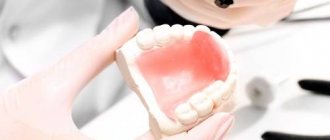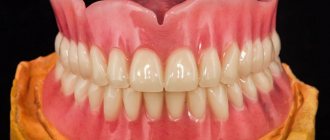A beautiful smile is easy! At the Esthetic Classic Dent clinic, we install the best permanent dentures that will last for many years and be easy to use. We offer a wide selection of crowns to suit every taste and budget, from budget to premium, and our specialists will take care of high-quality and painless installation. The newest permanent dentures look just like natural teeth, and sometimes even better. All that remains is to figure out what types of fixed prosthetics there are and for what cases they are suitable.
3 reasons to contact Esthetic Classic Dent
Fixed dentures - features and advantages
Fixed dentures are considered the most effective and inexpensive solution to restore dentition.
The most common causes of tooth decay and subsequent loss are:
- abundant carious lesions;
- pulpitis;
- periodontitis;
- dental cysts, etc.
As a result of these dental diseases, tooth crowns and roots are destroyed, teeth fall out on their own, or surgical intervention is required to remove dead hard tissues and roots. For restoration, the dentist recommends permanent dental prosthetics, the basis of which is a bridge and ceramic crowns of the latest generation.
Advantages of fixed dentures:
- Aesthetics. Fixed dentures are difficult to distinguish from your teeth. With proper selection and proper installation, the design looks harmonious in the oral cavity, and the person smiles boldly.
- Comfort. A person quickly gets used to a fixed denture and does not feel discomfort afterwards.
- There is no need to build up bone for high-quality implementation of a fixed denture. When using modern artificial roots, there is often no need to build up bone tissue. This simplifies the entire dental procedure and makes it much more affordable.
- Fast payback. The investment in fixed dentures always pays off in dental health, attractive visual effect and durability.
Why do you need dental prosthetics?
- With the complete loss or severe destruction of one or more teeth, deformation of the WHOLE dentition occurs - neighboring teeth shift towards the gap, tilt, there is a loss of physiological interdental contacts and, as a result, a disruption of the bite and the functioning of the entire dental system. So dental prosthetics is not only desirable, it is necessary, regardless of aesthetic ones - purely for medical reasons.
- Aesthetic indications for the installation of, for example, veneers are a separate issue, and here, of course, the patient’s desire plays the main role.
Advantages
The main advantage of fixed prosthetics is a complete solution to the patient’s problem – “set it and forget it.”
The main types of permanent dental crowns
At the stage of planning treatment with a fixed denture, the dentist, together with the patient, decides which type of fixed dental crown to use for high-quality prosthetics.
Currently, the most common fixed dentures are:
- Teeth crowns
They are used if the hard tissues of your tooth are destroyed by more than 2/3. The implementation of this type of fixed dental prosthetics occurs as follows:
- the tooth is strengthened with a supporting core and a fiberglass dental pin;
- the tooth is ground down;
- the dentist makes impressions of the tooth;
- After a week or two, a ceramic crown or one made of metal ceramics, plastic, zirconium dioxide, etc. “sits” on your tooth.
- a person receives a new healthy tooth that does not differ from his own either visually or in functional characteristics.
- Veneers – as a type of fixed denture
- their teeth are prepared;
- a thin ceramic onlay is fixed on the surface of pre-selected teeth;
- within a few hours the patient receives an impeccable effect - even, snow-white and beautiful teeth.
A veneer is a thin ceramic inlay that perfectly matches the shape, color, and transparency of your tooth. Such a fixed denture “sits” with the help of a special dental glue on the front wall of a previously ground tooth. Recently, super-thin permanent dental veneers have appeared, which practically do not require grinding of their crown, do not stick out, and look organic. As a rule, veneers are placed on the front six to ten teeth of the upper jaw (smile area). If the lower teeth are in good condition, whitening them is enough to achieve the ideal effect.
Installation of fixed dentures and veneers occurs as follows:
The average lifespan of veneers with proper use is up to 10 years.
Restoring ceramic inlays are used when more than ½ of the tooth crown is destroyed. Dental micro dentures are made from individual dental impressions in dental laboratories, fixed using a special dental bond, and prevent the occurrence of recurrent caries on the teeth.
Advantages of ceramic inlays (mini dentures) compared to composite fillings:
- high strength;
- durability of teeth (on average, from 3 years);
- ceramic systems do not absorb pigments and do not darken;
- retain their qualities throughout the entire period of validity.
Types of designs of fixed prostheses
In dental practice, various types of fixed dentures are used, which vary in their design, purpose and method of fixation.
Microprostheses
Overlays. We are talking about veneers and lumineers - thin plates designed to restore the aesthetics of the dentition. High-quality veneers are made of ceramics, and they are fixed to the tooth surface using cement. The thickness of veneers varies from 0.2 to 1.5 mm.
Tabs. Such microprostheses can replace light-polymer fillings, but they are more reliable and attractive. Along with veneers, inlays are used to change the shape and color of teeth that have lost their aesthetics. However, the inlays are fixed not on the surface of the tooth, but directly inside the crown. Inlays are made from various materials, but the most popular are ceramic.
Crowns
Crowns are, as a rule, a single prosthesis for teeth. This type of prosthesis is installed in cases where the tooth is destroyed by more than 50%. Thanks to the crown, the damaged tooth regains its strength and chewing function, while looking very aesthetically pleasing.
Crowns are made from various materials. There are metal, ceramic and metal-ceramic crowns. Metal crowns are made from cobalt-chromium alloy or gold. Ceramic crowns are based on porcelain and zirconium dioxide. Metal-ceramic crowns are based on alloys of precious metals, chromium-cobalt and chromium-nickel alloys.
Bridges
Bridge structures are a combination of several crowns (usually 3-4). The crowns located at the edges of the dentition serve as support, while the crowns in the center act as the prosthesis itself. This type of fixed dentures is used in the case of partial absence of adjacent teeth, and the presence of supporting teeth at the edges is mandatory.
Full jaw dentures (on implants)
In case of complete edentia, the most rational solution is to install dentures on the entire jaw. Such prostheses are usually attached to 4-6 implants. Dentures for the entire jaw are also called conditionally removable dentures, since they consist of two parts:
- non-removable (implants with a base for a crown)
- removable (artificial teeth in which metal-ceramic crowns are mounted, placed on bases attached to implants).
Despite the fact that such dentures have a removable part, only a doctor can remove it. Such high-tech modern designs are also called telescopic prostheses, since the joining of two parts is similar to the principle of the structure of a spyglass.
Classic dental bridge or fixed dental bridge
A classic bridge is a one-piece denture structure consisting of a base, as well as functional and supporting crowns. Functional crowns replace lost teeth, and abutment crowns serve as the basis for securely holding a fixed denture in the oral cavity.
Why do patients choose dental bridges?
- Deadlines. Prompt production of individual impressions in a dental laboratory - up to 14 working hours. days. With additional payment and comfortable conditions, it is possible to produce a fixed denture in 3–5 days.
- Indications for implantation. A fixed dental prosthesis is an excellent replacement system for diagnoses where there are restrictions on the implementation of titanium dental implants and the installation of crowns on these artificial roots.
- Price. The cost of a classic bridge is several times cheaper than the price of a titanium implant and a metal-ceramic or zirconium dioxide crown.
- No age restrictions. Bridges are often staged for both older people and middle-aged audiences.
The nuances of using a dental bridge with pre-implantation:
- You have to grind down your supporting teeth, albeit a little;
- It is often necessary to first remove the roots of the teeth before implantation.
What types of fixed prosthetics and when are they used?
In modern dentistry, there are the following technologies of fixed prosthetics:
- Microprosthetics
:
- installation of veneers/lumineers – used primarily for aesthetic reasons to correct chipped enamel, small defects in the front wall of the tooth, eliminate gaps, irreversible changes in enamel color, etc.
- Prosthetics with ceramic inlays help to reliably restore even a badly damaged tooth with a large cavity.
- Prosthetics using a crown
. This type of permanent prosthetics is used to restore a single tooth crown, even after its complete destruction, provided that the tooth root is preserved. - metal-ceramic
- metal-free
- zirconium.
. This type of fixed prosthetics is used when it is necessary to restore 1-2 lost teeth in the presence of neighboring ones and is often recommended as temporary.
Dentures on implants are indicated in the absence of a large number of teeth.
- Single implantation is the most reliable and aesthetic way to restore a tooth lost by the roots.
- Prosthetics of one jaw on 4, 6 implants
Prosthetics of the jaw or part of it on implants is the most modern, natural and reliable method of restoring dentition.
Video: interview with the head physician and orthopedist of the clinic R.Z. Babaev
Watch a video about how the entire process of high-quality dental restoration takes place - from the first visit, planning and to the implementation of the plan into a real smile. Watch an interview with Roman Zakirovich’s patient, Svetlana, and find out the main principle of a good doctor’s work.
Adhesive fixed bridge prosthesis
An adhesive fixed denture got its name due to the peculiarities of fixation on the supporting teeth. To connect it with living tooth tissues, adhesion is used, that is, “sticking” technology. For reliable bonding, the prosthetist uses a dental primer, bond, some types of acids (for example, phosphoric acid), chemical or light-curing cement.
Adhesion helps to secure the ceramic tooth and onlay processes to the supporting teeth without removing the roots and grinding away a large layer of its enamel.
Structure of an adhesive dental bridge:
- main abutment tooth;
- side linings in the form of processes (petals), onto which a fixing compound is applied.
The average lifespan of an adhesive dental bridge is up to five years.
Fixed denture on titanium implants
Fixed dentures on dental implants are one of the most common systems for restoring lost teeth.
The main advantages of such solutions:
- titanium implants installed in deep bone layers preserve hard tissue around them;
- healthy supporting teeth do not require preliminary grinding and root removal;
- the average shelf life of such dentures on artificial roots is twenty years;
- the method of restoring teeth with fixed dentures is considered the most gentle and natural;
- ready-made solution for restoring edentulous teeth;
- attractive dental aesthetics.
The only caveat when installing a fixed dental structure on implants is the considerable cost of the solution.
If we compare all the existing options for fixed dental prosthetics, it is the fixed prosthesis on a dental implant that is the best solution - in terms of quality, aesthetics, reliability and durability of the teeth.
How to care for fixed dentures?
Basic rules for proper care of fixed dentures at home:
- brushing teeth with a brush and dental floss;
- using a dental irrigator (preferably after every meal);
- hygienic cleaning of the tongue.
- preventive visits to the dentist’s office (at least twice a year) to control the quality, reliability of fastening and aesthetics of a fixed dental prosthesis (bridge);
Don't forget to clean the surface of your tongue, where just as many bacteria accumulate as on your teeth and gums. These organisms provoke the development of caries. To clean your tongue at home, use a hygienic scraper with a rough surface, which can be purchased at a clinic or any pharmacy.
If the patient wears fixed dental prostheses made of metal-ceramics or ceramic crowns, experts recommend checking the so-called supercontacts (heightened areas of the bridge) at least 2 times a year and grinding them to avoid chips and mechanical damage to the dental bridge.
If you feel that the bridge or individual teeth have begun to loosen, you should urgently consult a dentist. In case of mechanical damage to a fixed denture, the defects can be eliminated without replacing the structure with a new one. If you lose time, you will have to resort to dental prosthetics again using a new bridge.
Timing of prosthetics
Depending on the type of prosthetics, the duration of restoration can last from 3-5 days to 1.5-2 weeks. The timing of the work is also influenced by the preparatory stage: if when installing lumineers there is no need to prepare units, then fixed dental prostheses in the form of a bridge require a preparatory stage, which can take about 1-2 months.
Advantages
Fixed structures have a number of advantages:
- long service life (veneers - up to 7 years, stump inlays - up to 20 years);
- strength and reliability of fastening;
- aesthetics (lumineers and ceramic crowns, which are difficult to distinguish from a “natural tooth”);
- performance (the ability to withstand chewing loads on the prosthesis, completely replacing living units);
- do not reduce the sensitivity of taste and thermoreceptors.
Adaptation lasts about 2-3 weeks, after which patients completely forget about the foreign object in their mouth.
Care
Oral hygiene after installation of a prosthesis is almost no different from conventional procedures:
- You should brush your teeth twice a day and rinse with an irrigator;
- buy high-quality paste, do not try to save money on purchasing hygiene products;
- systematically visit the dentist for professional cleaning of the oral cavity and diagnosis of possible pathologies in the early stages;
- do not try to repair a broken prosthesis at home;
- give moderate load on artificial units. If you have a temporary denture installed, avoid temperature changes: prepared teeth are hypersensitive, so pain may occur.
Average price of fixed dentures in Moscow clinics
- Types of dentures
- Efficiency of production
- Qualifications of specialists
- Type of clinic
The price of a fixed denture depends on the following factors:
A budget option is a plastic bridge, which is usually installed as a temporary solution to replace lost teeth. Metal stamped dental bridges are also cheap - from 300 rubles. for one unit. The most expensive are bridges with ceramic crowns, which cost about 30,000 rubles. for 1 tooth.
Fixed dentures are usually made from pre-made impressions in a dental laboratory. The average production time is two weeks, but some services offer to speed up this process for a fixed additional payment (from 1/3 of the cost to double the price, depending on the complexity of the work).
Dental prosthetics requires the help of several specialists: a prosthetist, an implantologist, and a dental technician. The dependence is obvious: the higher the qualifications of the professional, the higher the final price of dental prosthetics.
The price of the same fixed denture in different clinics may differ. If you compare the prices of Moscow dentists, the most favorable prices are from the network of dental clinics “32 Dent”.
Medical Internet conferences
Karpenko G.V.
Scientific supervisors: Ph.D. Perunov A.Yu., Krechetov S.A.
Karpenko G.V.
Karpenko G.V.
Scientific supervisors: Ph.D. Perunov A.Yu., Krechetov S.A.
Karpenko G.V.
Scientific supervisors: Ph.D. Perunov A.Yu., Ph.D. Krechetov S.A.
GBOU VPO Saratov State Medical University named after. IN AND. Razumovsky Ministry of Health of Russia
Department of Orthopedic Dentistry
Goal of the work
To study the advantages and disadvantages of each method of fixation of fixed orthopedic structures supported by implants.
Job Objectives
1) Describe various methods of fixation of fixed orthopedic structures supported by implants.
2) Consider the advantages and disadvantages of each method in various clinical situations
3) Analysis of the examination of patients
Research materials
The analysis was carried out in 32 patients during a preventive examination who had orthopedic structures in the oral cavity supported by implants, which were installed from 1 to 10 years ago.
Implant-supported prosthetics, depending on the type of connection between the superstructure and the implant, can be divided into:
- cemented prostheses
- screw-fixed prostheses
-combined type of fixation of prostheses - cement-screw (Screw & Cement Retained Protheses-SCRP).
These types of fixation have their own exceptional advantages and disadvantages.
Table 1. Advantages and disadvantages of different types of fixation.
Biomechanical criteria.
In terms of biomechanical aspects, cemented and CV orthopedic designs are relatively better. When installing screw prostheses, it is generally very difficult to achieve passive fit and adhesion, especially when prosthetics are used with long-length structures. This is due to the fact that the creation of these structures requires additional clinical and laboratory stages, at each of which errors are possible. The presence of small technological gaps is the main criterion that complicates the passive fit of the structure, which is almost impossible to achieve even using laser welding techniques, the spark erosion method and connecting the cut parts of the prosthesis by soft soldering.
During the day, during the operation of the masticatory apparatus, reversible cyclic deformation of the bone tissue of the upper and lower jaw occurs. Hobkirk and Schwab showed in their study that osseointegrated implants in edentulous patients move relative to each other during mandibular movements. The displacement can reach 420 microns, and the pressure of the connected implants on each other is -16 N. These indicators can vary depending on the distance between the implants and the thickness of the bone tissue.
All the disadvantages of screw structures lead to the fact that under the influence of occlusal load there is a possibility of weakening or fracture of the screw. And even an implant. Also, excess stress that occurs in screw-retained prostheses can be transferred to the bone tissue surrounding the implant.
In cemented and cement-screw prostheses, given the presence of a gap of 25-30 microns for cement, it is possible to achieve an ideal fit. Filling the gaps between the indirect restoration and the abutment with cement material after the passive connection of the abutment and the implant reduces or completely compensates for the presence of inaccuracies, eliminating preload and more evenly distributing the load on the implant, and accordingly, on the bone tissue.
Retention and occlusal relationships.
Retention is the leading criterion that affects the long-term functioning of the structure.
Retention depends on several factors:
-convergence of axial surfaces
-height and area of contacting surfaces
-microrelief of surfaces.
Jorgensen has proven that a convergence of 6 degrees is ideal for the preparation of natural teeth, and the same figure is also true for implant-supported prosthetics. Most implant systems have this taper on standard abutments. When using individual abutments in cemented CV structures, a 6-degree taper is also recreated during the milling process. The height of the walls of standard abutments is greater than the walls of the tooth, but the surface area is less. A custom abutment can be manufactured with criteria that replicate the morphology of the natural tooth.
In a number of studies, it has been observed that a rougher surface creates better retention. It is possible to achieve greater surface roughness by sandblasting the abutment and the internal surface of the structure. However, provided that the taper is maintained and the axial walls are of sufficient height, there is no need to create greater roughness.
Occlusion is another factor influencing the choice of type of structure fixation. The problem of insufficient interocclusal height during prosthetics can be solved through the use of screw structures. The advantage of screw-retained prostheses is the ability to reduce the height of the clinical crown without loss of retention.
However, screw and cement-screw fixation presupposes the presence of a hole on the occlusal surface of the implant - the exit of the screw shaft, which can occupy from 1/3 to ½ of the entire occlusal surface of the crown. This hole must be closed for aesthetic purposes in various ways, which in turn complicates the concept of correct interocclusal contacts achieved by the dental technician in the articulator. The area of occlusal surface occupied by the screw shaft hole is very important for creating correct occlusion, especially in the molar area. Often, a composite material is used to eliminate an aesthetic defect and close the screw shaft hole, however, according to Ekfeldt and Oilo, the resulting occlusal contacts do not remain stable due to abrasion of the composite material by the opposing tooth, especially when it comes to ceramic restorations. With true cement fixation, it is possible to achieve ideal occlusal contacts that will be stable for a long time.
Correction of implant angulation.
One of the main problems when eliminating defects in the dentition by installing implants is their parallelism. For one reason or another, a dental surgeon cannot always achieve parallel placement of implants, which complicates the task of prosthetics for an orthopedic dentist. When using structures with cement-screw and screw fixation, it is possible to adjust the angle of inclination of the implant axis through the use of standard angular and individual abutments. In screw-retained prostheses, this possibility is limited.
Aesthetic criterion.
The aesthetic appearance of the structure is an integral part of competent and complete orthopedic treatment, and often takes precedence after the functional aspect.
In prostheses with screw and cement-screw fixation, a solution to the problem of correcting the aesthetic component is required, especially if the exit of the screw shaft is located on the vestibular surface of the crown. These aesthetic defects can be eliminated in several ways.
Closing the defect with filling material is the simplest and cheapest way. This method makes it possible to achieve acceptable aesthetic results without special costs and complex manipulations, however, the composite material cannot boast of stability over a long period of time, and it is also quite difficult to select a color shade for the existing orthopedic restoration, without using a special set of dyes for composite materials.
The most acceptable in aesthetic and functional terms is the use of specially manufactured inlays using e.max press technology. These inlay or onlay inlays are made directly by the dental technician, which allows you to achieve not only excellent aesthetic results, but also helps create precise occlusal contacts.
Installation and maintenance of the structure.
Most modern implantation systems have an internal conical type of connection between the implant and abutment, which allows achieving excellent functional and hygienic results. However, this type of connection requires precise fit of all components of the prosthesis, which requires X-ray control after installation of the structure, both with screw and cement-screw and cement fixation.
Another feature when installing prostheses with the SCRP fixation type on implants with an internal fixation type is the limitation of the “path of insertion” due to the wide and long contact surface between the implant and the abutment.
Structures with screw and cement-screw fixation can be easily removed if necessary. This need arises when: replacing orthopedic components of the structure; fracture of the screw or abutment; various modifications and repairs of the prosthesis; periodontal diseases requiring periodic treatment. The possibility of removing the structure significantly increases the safety of treatment and is an advantage of these types of fixation over cement.
Presence of residual fixing material.
For a long-term prognosis of the functioning of prostheses with a screw type of fixation, an X-ray image is sufficient to confirm the correct fit of the superstructure to the implant.
Restorations that have a cement type of fixation, in addition to X-ray examination, require, after installation, careful removal of excess cement, which affects the condition of the tissues around the implant and can cause iatrogenic inflammation. In addition, the very procedure of removing excess cement with various instruments, in particular a probe, leads to the formation of scratches on the ceramic surface of the prosthesis. Scratches contribute to the formation of plaque on the surface of artificial crowns, which also leads to deterioration of the soft tissues. Therefore, the edge of a cemented fixed structure should be located within no more than 1 mm apical to the gingival margin.
Prostheses with cement-screw fixation have the advantage that they can be cemented onto the abutment directly on the plaster model, then the excess fixing material can be removed, polished and transferred into the oral cavity, fixed to the implants.
Analysis of the examination of patients.
Of the 32 patients with orthopedic structures supported by implants: 12 patients with cement fixation, 10 patients with screw and 11 with cement-screw type of fixation.
During a routine examination of patients with a cement type of fixation, 2 patients were found to have remains of the fixing material and inflammation of the soft periodontal tissues. Excess cement was removed and anti-inflammatory therapy was prescribed. In 7 patients with screw and cement-screw type of fixation, who received prosthetics more than 5 years ago, failure of the filling material used to close the hole in the abutment screw shaft was revealed. There was a change in the color of the filling, abrasion and a violation of the marginal seal. The filling material was replaced with new one.
One of the patients with a screw type of fixation complained of mobility of the crown during the act of chewing; during the examination, a weakening of the screw connection was revealed. In this patient, the following was performed: 1) removal of the composite material covering the hole in the screw shaft; 2) replacing the screw with a new one; 3) tighten it with a force of 30 Ncm, according to the manufacturer’s recommendations; 3) closing the hole with a composite filling material.
In the remaining patients, the examination did not reveal any violations, the orthopedic structures were sound, and there were no changes in the periodontal tissues.
Conclusion.
There is no single “best” way to install a prosthesis on implants, and each individual clinical case requires careful planning and selection of the optimal method that will solve a particular clinical problem.
